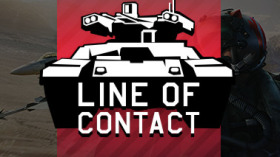
- PC平台
- MAC平台
- Linux平台
- 操作系统:Windows 10 (64位)
- 处理器:双核 2.2 GHz
- 内存大小:4GB
- 图形处理器:DirectX 11 级别的显卡 - AMD Radeon 77XX / NVIDIA GeForce GTX 660 (游戏支持的解析度最低为720P)
- 网络:宽带网络连接
- 硬盘空间:22.1 GB (极简客户端)
- 操作系统:Windows 10 / 11 (64位)
- 处理器:英特尔 Core i5 或 Ryzen 5 3600 及以上
- 内存大小: 16 GB 或更高
- 图形处理器:DirectX 11 及以上级别的显卡 - Nvidia GeForce GTX1060 / AMD Radeon RX 570 同等级及更高
- 网络:宽带网络连接
- 硬盘空间: 62.2 GB (完整客户端)
- 操作系统:Mac OS Big Sur 11.0 或更新版本
- 处理器:Core i7,至少需要 2.2GHz (不支持Intel Xeon系列)
- 内存大小:6 GB
- 图形处理器: Intel Iris Pro 5200 (Mac) 或同等水平的 AMD / Nvidia显卡 (游戏支持的解析度最低为720P)
- 网络:宽带网络连接
- 硬盘空间: 22.1 GB (极简客户端)
- 操作系统:Mac OS Big Sur 11.0 或更新版本
- 处理器:Core i7 (不支持Intel Xeon系列)
- 内存大小:8 GB
- 图形处理器:Radeon Vega II或更高,需要支持Metal
- 网络:宽带网络连接
- 硬盘空间:62.2 GB (完整客户端)
- 操作系统:大部分现代 64 位 Linux 系统发行版
- 处理器:双核 2.4 GHz
- 内存大小:4 GB
- 图形处理器:NVIDIA GTX 660 及最新显卡驱动 (至少为半年以内的版本) 或同等水平的 AMD 显卡及最新的显卡驱动 (至少为半年以内的版本)。游戏支持的解析度最低为720P。显卡需要支持Vulkan API
- 网络:宽带网络连接
- 硬盘空间: 22.1 GB (极简客户端)
- 操作系统:Ubuntu 20.04 64位
- 处理器:Intel Core i7
- 内存大小: 16 GB
- 图形处理器:NVIDIA GTX 1060 与最新显卡驱动 (至少为半年以内的版本) 或同等水平的 AMD 显卡 (如 Radeon RX 570) 及最新的显卡驱动 (至少为半年以内的版本)。
- 网络:宽带网络连接
- 硬盘空间:62.2 GB (完整客户端)

Today, we’ll be talking about changes to the post-pen effects for APHE shells used by ground vehicles that we plan to introduce into the game. We’re ready to show you what we have planned here, and at the end of this news post you can participate in voting for or against — whether there’ll be changes or not all depends on your vote. Let’s take a look!
Preserving fragments in the head part of the shell
First off, we’d like to tell you about a change that we consider necessary and will be implemented into the game without any vote. This change relates to maintaining the integrity of an APHE shell’s head after armor penetration. When an APHE shell explodes, its warhead is not subject to significant fragmentation and can cause substantially greater damage than the scattering fragments of the case and base.
The fragment of the shell’s warhead is significant in mass, can penetrate armor of considerable thickness, and at the same time also form secondary fragments when penetrating armor. This change will allow the warhead to better hit enemy crew members located behind internal partitions, such as the engine compartment bulkhead, as well as other modules along the shell’s flight trajectory that cannot be penetrated by small fragments generated from the shell exploding.
Increasing secondary fragments and high explosive damage

Due to a number of technical reasons, secondary fragments from APHE shells differ and are worse compared to fragments from regular, solid AP shells. When reworking fragmentation fields, we’ll enhance the secondary fragments of APHE shells to the level of solid AP shells.
The high-explosive damage from APHE shells will remain — it causes relatively little damage, affects the crew and modules inside the tank and has a damage zone in the form of a sphere around the detonation point of the shell. The diameter of the damage sphere of high-explosive damage is noticeably smaller than the scattering zone of secondary fragments.
Implementing fragment areas
Here are the changes that we’d like you to vote on, whether they’re introduced or not will be determined by community vote: scattering sectors of fragments from APHE shells.
When a shell explodes, three main fragmentation areas are formed, shown in the image below:
- The remainder of the shell’s head and its fragments.
- Fragments from the base of the shell.
- Fragments from all sides of the shell (the case).
When a shell explodes inside of a tank or armored vehicle, the shell’s head acts as a small solid AP round and may penetrate more internal modules. Alongside this, smaller fragments from the shell casing form a fragmentation cone and hit the crew and modules around the explosion point. We plan to implement both of these to the game.
*Translation (Pic.113): Scattering of the APHE shell fragments on impact
At the moment, we use a simplified fragmentation pattern for APHE shells in the game without segmentation into different areas. If we were to implement the proposed physically reliable sector fragmentation patterns for APHE shells, the post-pen effect of APHE shells will be more realistic. However, when hitting protruding modules, such as the commander’s cupola, the probability of crew damage would be reduced.
Reworking the post-pen effects of APHE shells can change the tactics of the game, making protruding weakened areas less vulnerable. However at the same time, post-pen effects after penetrating the hull of a vehicle due to the preservation of the shell’s head after the shell explodes will be increased.
We’d like to hear your opinion on this — share it in the comment field and vote Yes or No for the changes to post-pen effects in the poll!
In-game examples of the described changes

Here’s some screenshots of how damage to ground vehicles will be altered with the changes implemented.
Post-pen effect when penetrating the center of a tank without preserving the head of the shell (before) vs while preserving the head of the shell (after):


Before
After
Post-pen effect when the commander’s cupola is hit by a spherical spread of fragments from a shell explosion (before) vs hit with a physically reliable sectoral scattering of fragments from the shell explosion (after):


Before
After
We’re planning to give players the opportunity to test these changes in a special game event, as well as the “Protection Analysis” menu, before applying these changes to all APHE shells in the game. However, preparing this testing will require some significant time from the development team, so today we want to collect your opinions on whether you’re interested in switching to a more detailed damage model for APHE shells. So, shall we test it?
If you’re interested in testing, we’ll start preparing it and will host another voting on this change based on its results.









评论 (0)
评论将处于预审核状态提交举报